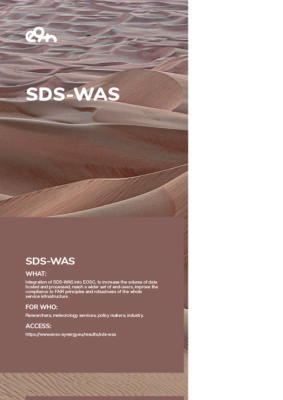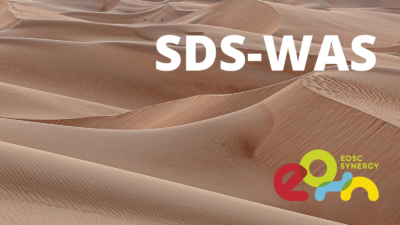Description of the Result
SDS-WAS provides a set of services related to the mineral dust forecast. It collects numerical model outputs and observational data from a wide set of worldwide partners plus internally developed. A wide set of post-processed analysis and statistics are generated, and results in the form of plots, tables or numerical (binary) data are disseminated to a variety of users (public institutions, researchers, etc ). Finally, SDS-WAS also organises training courses on dust related research, to give capabilities for generated products usages and other kinds of events (seminars, workshops) related to dust research. The aim is to give support to institutional entities (e.g. National Meteorological
Agencies) to warn about possible dust events and to foster the study of dust-related phenomena into the academic and research communities. The EOSC infrastructure will give the possibility to increase the volume of data hosted and processed, reach a wider set of end-users, improve the compliance to FAIR principles and robustness of the whole service infrastructure.
Target audience/beneficiaries
Researchers in Climate and Weather Forecast, national meteorological services, international meteorological organisations, policy makers and (sometimes) industry.
Added Value / Benefits
In terms of amount, mineral dust is the second aerosol present in the atmosphere, and dust storms have a huge variety of implications on human health and many economical fields (aviation, transports, agriculture). The WMO (World Meteorological Organisation) favoured the creation of various Regional Nodes for dust storms forecast; the SDS-WAS – Barcelona Dust Regional Centre, is the one in charge of Northern Africa, Middle East and Europe.
SDS-WAS:
- provides real- time dust forecast products from an ensemble of numerical models outputs provided by partners or developed in-house;
- produces derived products of data analysis (skill scores, statistics – quantitative) and data evaluation of forecast vs observations (in-situ and satellite – qualitative);
- provides an interactive platform to visualise maps, time-series and numerical tables;
- provides a data download service of numerical model outputs;
- disseminates numerical data and images through international channels like GAW (WMO) and EUMETCAST (EUMETSAT);
- organises training courses and workshops to current or potential users and partners on dust products and services.
Use and Impact after EOSC Synergy
Work on the service started in 2010 with a research & development infrastructure, becoming an international reference for dust forecast, and became operational in 2016 with the o cial recognition by WMO. We are the first operational centre on sand and dust storms forecast recognised by the WMO. Collaboration is ongoing with african research centres to provide them with forecasts to study the impact and prevention on meningitis epidemics (https://sds-was.aemet.es/materials/meningitis). The portal nowadays serves industry users, such as: Gas Natural Fenosa; NCAR; Meteoplay; the Dubai Intl. Airport; and Meteo Services and Universities of almost all countries of the domain (Northern Africa-Middle East-Europe). Dissemination is done via targeted newsletters, webinars, workshops and training courses.
 DS-WAS KER Brochure [PDF]
DS-WAS KER Brochure [PDF]